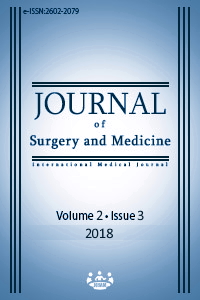Acute toxicities of three-dimensional conformal radiotherapy in the treatment of gynecological cancer, and retrospective dosimetric comparison of three dimensional conformal radiotherapy and invers intensity-modulated radiotherapy
Keywords:
Gynecological cancer, Acute toxicities, Conformal radiotherapy, Quality of life, Intensity modulated radiotherapyAbstract
Aim: The study was designed to compare the critical organ and bone marrow doses with three-dimensional conformal radiotherapy plans and intensity-modulated radiotherapy re-treatment plans and to evaluate acute toxicities of three-dimensional conformal radiotherapy for gynecological cancer.
Methods: Twenty-eight patients who underwent conformal radiotherapy (3D-CRT) were evaluated retrospectively and were re- planned according to IMRT technique. The critical organ and bone marrow doses of patients were compared dosimetrically. Evaluation of early side effects was performed using RTOG toxicity scale and European Organization for Research and Treatment of Cancer (EORTC) QLQ30 side effect evaluation questionnaire.
Results: The assessment of early toxicity revealed Grade 1 lower gastrointestinal (GIS) toxicity in 16 (57.1%) patients, grade 1 upper GIS toxicity in 9 (32.1%) patients, grade 1 hematological toxicity in one (3.6%) patients, grade 1 genitourinary toxicity in 15 (53.6%), grade 1 skin toxicity in (50%) 14 patients . One patient (3.6%) had grade 2 upper GIS toxicity, 11 patients (39.3%) had grade 2-3 hematological toxicity. Bone marrow V20 (p<0.001), V95 (%) of bone marrow (p<0.001), urinary bladder V40 (p<0.001), urinary bladder mean dose (p<0.001), rectum V40 (p<0.001), rectum mean dose (p<0.001), small bowel V40 (p<0.001) were received lower doses in the IMRT planning arm than the conformal planning arm.
Conclusion: 3D-CRT is a safe treatment with acceptable low toxicity levels in gynecological cancer patients, and it does not adversely affect quality of life. IMRT reduce dose to the bone marrow and the normal tissues as compared to 3D-CRT.
Downloads
References
SEER Cancer Statistics Review, 1975–2010 [Internet]. seer.cancer.gov; Apr. 2013 Available from: http://seer.cancer.gov/csr/1975 2010/ based on November 2012 SEER data submission, posted to the SEER web site.
Bray F, Loos AH, Oostindier M, Weiderpass E. Geographic and temporal variations in cancer of the corpus uteri: incidence and mortality in pre- and postmenopausal women in Europe. Int J Cancer. 2005;117(1):123–31.
WHO.GLOBOCAN 2012: Estimated cancer incidence, mortality and prevalence worldwide in 2012. http://globocan.iarc.fr/Pages/fact_sheets_population.aspx (3 April 2015, date last accessed).
Lee NK, Cheung MK, Shin JY, et al. Prognostic factors for uterine cancer in reproductive-aged women. Obstet Gynecol. 2007;109:655–62.
National Cancer Institute. Endometrial cancer treatment Physician Data Query (PDQ).2015; http://www.cancer.gov/cancertopics/pdq/treatment/endometrial/healthprofessional (1 April 2015, date last accessed).
Ferlay J, Shin HR, Bray F. GLOBOCAN 2008: cancer incidence and mortality Worldwide: IARC Cancer Base No.10. Lyon, France: International Agency for Research on Cancer. 2010; http://globocan.iarc.fr.Google Scholar
Mauch P, Constine L, Greenberger J, Knospe W, Sullivan J, Liesveld JL, et al. Hematopoietic stem cell compartment: Acute and late effects of radiation therapy and chemotherapy. Int J Radiat Oncol Biol Phys. 1995;31:1319-39.
Mell LK, Tiryaki H, Ahn KH, Mundt AJ, Roeske JC, Aydogan B. Dosimetric comparison of bone marrow-sparing intensity-modulated radiotherapy versus conventional techniques for treatment of cervical cancer. Int J Radiat Oncol Biol Phys. 2008;71:1504-10.
Brixey CJ, Roeske JC, Lujan AE, Yamada SD, Rotmensch J, Mundt AJ. Impact of intensity-modulated radiotherapy on acute hematologic toxicity in women with gynecologic malignancies. Int J Radiat Oncol Biol Phys. 2002;54:1388-96.
Small W Jr, Mell LK, Anderson P, Creutzberg C, De Los Santos J, Gaffney D, et al. Consensus guidelines for delineation of clinical target volume for intensity-modulated pelvic radiotherapy in postoperative treatment of endometrial and cervical cancer. Int J Radiat Oncol Biol Phys. 2008;71:428-34.
Lim K, Small WJ, Portelance L, Creutzberg C, Jürgenliemk-Schulz IM, Mundt A, et al. Consensus guidelines for delineation of clinical target volume for intensity- modulated pelvic radiotherapy for the definitive treatment of cervix cancer. Int J Radiat Oncol Biol Phys. 2011;79:348-55.
Yamazaki A, Shirato H, Nishioka T, Hashimoto S, Kitahara T, et al. Reduction Of Late Complications After İrregularly Shaped Four-Field Whole Pelvic Radiotherapy Using Computed Tomographic Simulation Compared With Parallel opposed Whole Pelvic Radiotherapy. Jpn J Clin Oncol. 2000;30:180–4.
Mundt AJ, Lujan AE, Rotmensch J, Waggoner SE, Yamada SD, et al. Intensity-modulated whole pelvic radiotherapy in women with gynecologic malignancies. Int J Radiat Oncol Biol Phys. 2002;52:1330–7.
Liu SP, Huang X, Ke GH, Huang XW. 3D radiation therapy or intensity-modulated radiotherapy for recurrent and metastatic cervical cancer: the Shanghai Cancer Hospital experience. PLoS One. 2012;7(6):e40299. doi: 10.1371/journal. pone.0040299. Epub 2012 Jun 29.
Nout RA, Putter H, Jobsen J. Jurgenliemk-Schulz I.et al. Five-year quality of life of endometrial cancer patients treated in the randomised Post Operative Radiation Therapy in Endometrial Cancer (PORTEC–2) trial and comparison with norm data. Eur J Cancer. 2012;48 (11):1638-48.
Heron DE, Gerszten K, Selvaraj RN, et al. Conventional 3D conformal versus intensity- modulated radiotherapy for the adjuvant treatment of gynecologic malignancies: a comparative dosimetric study of dose-volume histograms. Gynecol Oncol. 2003;91(1):39-45.
Avinash HU, Arul Ponni TR, Janaki MG, Kirthi Koushik AS, Kumar SM. A prospective dosimetric and clinical comparison of acute hematological toxicities in three-dimensional conformal radiation therapy and intensity modulated radiation therapy with concurrent chemotherapy in carcinoma cervix. J Can Res Ther. 2015;11:837.
Downloads
- 1424 1615
Published
Issue
Section
How to Cite
License
Copyright (c) 2018 Halil Sağınç, Özgür Yıldırım, Bahar Baltalarlı
This work is licensed under a Creative Commons Attribution-NonCommercial-NoDerivatives 4.0 International License.















